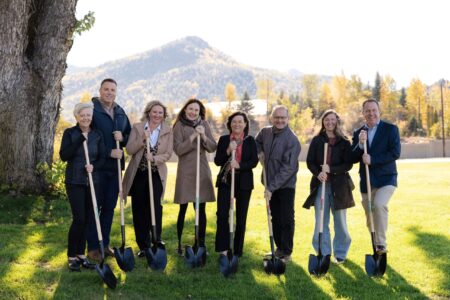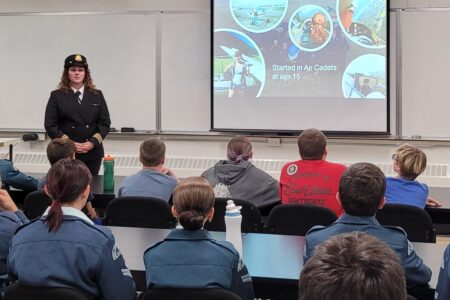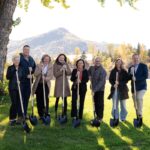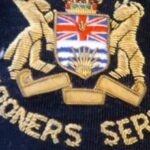K-12 at RSS the only ‘decent’ solution, claims local group in school board presentation
Rossland’s Neighbourhoods of Learning (NOL) committee gave a presentation to the School District No. 20 (SD20) board on Monday evening, arguing that K-7 at MacLean Elementary makes no sense, but that K-12 at RSS is doable, even a “win-win-win” solution to the problem of closing a $1.5 million gap in SD20’s limited budget.
“What is the best solution for Rossland Schools?” asked presenter Linda Schulze, a parent and NOL member standing in for NOL coordinator Jennifer Ellis and the presentation’s author, Shelley Ackerman, neither of whom were able to attend the meeting.
The full presentation is available online.
The first thrust of NOL’s argument was that MacLean is already full with K-5, let alone K-7. MacLean has the second smallest elementary school building in SD20, and the least amount of space per student.
Trustee Toni Driutti—representing Warfield and parts of electoral areas B of RDKB and J of RDCK—said K-7 used to fit in MacLean, and asked Schulze why it wouldn’t now. The classrooms are not smaller and class sizes haven’t increased.
Schulze was surprised at the question, and only realized the answer on her way home: “Yes, K-7 used to be in MacLean, but that’s when we had two elementary schools,” she told the Telegraph on Tuesday. “The Cooke Ave. school was open, and we only had half-day kindergarten at that time, and no StrongStart.”
Driutti then asked, aren’t there empty classrooms in MacLean? Schulze said, “She was getting at the fact that we have StrongStart. Personally, I don’t consider StrongStart an empty classroom. You just have to walk through MacLean to see how full it is.”
With small classrooms, narrow hallways, and only one set of bathrooms, NOL says there is no room for the Grade 6s and 7s. Furthermore, with only 1.1 hectares—the smallest schoolyard in SD20—they said there was no room for portables and it would be “unconscionable” to make it even smaller.
Trustee Lorrain Manning of Trail asked why NOL didn’t include the concrete roof-top on the east side of MacLean in the 1.1 hectares.
Schulze replied, “In fact, we did include that in the 1.1 hectares.”
For comparison, NOL took Glenmerry Elementary which, at 9.69 square metres per student, has the least amount of space per student after MacLean’s 8.98 square metres per student.
To make the student density of Glenmerry and it’s 2 hectare schoolyard equivalent to what MacLean would be with K-7, however, “you’d first have to subdivide off 45 per cent of the schoolyard … [the four] portables would be removed, and 545 square metres of the school would be lopped off,” NOL said in the presentation.
After running a similar exercise with Fruitvale’s small school, NOL argued, “All of the other schools in the district have much more space per student than MacLean with K-7”
An additional problem, NOL said, is that enrolment over the last two years has been so much larger than expected that a new division has been added to MacLean.
Schulze has personal experience: “When my son was in kindergarten there were 44 kids. Now he’s in Grade 1, there are 56. That has nothing to do with birth numbers in the interior or at Trail hospital. That’s 12 kids in one year that they couldn’t have planned for. They all came from away—families that have moved to Rossland.”
Furthermore, with a growth rate of 8.5 per cent since the last census, Rossland is the fastest growing community in the RDKB. Because MacLean cannot be added onto, there is no room for future growth.
On the other hand, NOL argued, RSS has room for all the K-12 students: “If you put the current 544 K-12 students into the RSS building, they would have 14.96 square metres per student—twice as much space as putting K-7 at MacLean, even with portables. The hallways are wide, the classrooms are large, and there are several bathrooms.”
NOL acknowledged that RSS is expensive to run, with the highest cost per student in the district.
“But, if you combine K-12 at RSS, that brings the cost down to $8,770 [per student], putting it right in the middle of the costs [per student] of all the schools in the district,” NOL said in the presentation.
NOL contrasted the savings of K-12 at RSS with the costs of closing RSS: these costs include six portables at J.L. Crowe, plus the capital, maintenance, fuel, and staffing costs of bussing between 150 and 225 students down and up the hill each day.
The closed RSS building would still incur an annual maintenance cost, and SD20 funding could decrease further as some Rossland parents would choose to move or homeschool instead, NOL said.
Furthermore, there’s already a potential buyer for MacLean—SD93 for the École des Septs Sommets. “Whether or not it can be sold is up to the ministry,” Schulze explained, but SD93 have put their interest forward. They’re not interested in RSS.”
Schulze added, “This is my personal opinion, but I think [SD20’s board] is in a tough spot. They have to cut $1.5 million, and RSS has been on the chopping block for many years. It’s somewhat of an easy target, and they really want to close RSS, but I don’t think they’re totally convinced that it’s the right thing to do. The only way they can sensibly close RSS is by jamming the 6s and 7s back into MacLean. We [NOL] are just saying that it’s not an option. It’s not down to opinion, it’s down to looking at the facts and how many kids we have in that school.”
With a small student population, however, opponents to K-12 at Rossland argue that senior students can’t get the courses they need. The NOL counters this argument in several ways.
For one, based on standardized testing of all public high schools in BC, the most recent Fraser Institute report ranked RSS fifth in the province.
More broadly, RSS addresses small class sizes with a “blended learning” approach that combines multi-grading, face-to-face instruction, online courses, off-timetable courses, and other “21st Century initiatives” such as “personalized learning” models that will give RSS “the ability to offer greater course selection than many schools in BC,” NOL claimed.
Schulze explained, “RSS has struggled in the recent past because we don’t have the numbers of a Beverley Hills High. When they want to offer a Chem-11 course, for example, they may only have 10 kids who want to take it. That’s not cost effective, so they have multi-graded classes with, say, Grades 10 and 11. Part of it is the teacher standing up at the front, and part of it is online learning—the student takes something that interests them and they go with that. They seek out the facts with respect to that chemistry problem they set themselves using the Internet, using their teacher.”
“For some kids, that’s very effective,” Schulze said. “They’re engaged, they’re picking their topics, they’re really interested in finding out the answer. Other kids are really good at absorbing from a teacher at front of classroom, so it’s a bit more of a struggle. That’s why blended learning is so valuable, it’s a mix of both.”
RSS has already proven itself valuable to some students who commute from outside Rossland—57 students, some 18% of enrolment, in the 2010-2011 school year. “For some,” NOL said, “the choice is critical to their success.”
NOL also made it clear that the transportation issue was more than just the cost of buses. “Extra-curricular involvement is equally important for student growth,” they argued. “Most RSS students are involved in other activities … Many couldn’t participate if they had to follow a bus schedule.”
Another common argument against K-12 came from Trustee Mickey Kinakin representing electoral area I and part of electoral area J of the RDCK. His concern was the mingling of primary and secondary kids, and the risk of older students’ poor behaviour choices impacting and influencing the younger students.
“I personally don’t understand it,” Schulze said, “but f I step out of my own values, I can see the concern from elementary parents. It’s not overwhelming, but the concern exists. It’s the responsibility of NOL to allay those fears.”
To that end, NOL visited the K-12 school in Kaslo. “They have the same kind of community, the same numbers, the same lifestyle,” Schulze said. “And their school is a beautiful thing.”
Schulze related one anecdote from Kaslo’s principal: A low achieving Grade 9 didn’t fit in, was a little bullied, had no friends, and was headed down the wrong path. Then he was given the task of reading to a kindergarten class once each week.
“To those kindergarten kids, he was a hero,” Schulze said. “It gave him a sense that, ‘I’m a worthy person, there are things I can do, I can be a role model.'”
Furthermore, a recent NOL poll of Rosslanders received 518 responses, of whom 94% were supportive of a K-12 solution—72 per cent were “strongly” supportive. Only 8 per cent preferred the solution of K-7 at MacLean. In the same survey, 45 per cent would consider moving from Rossland if RSS were closed, and 90 per cent would consider an in-town independent school as an alternative to bussing down the hill.
In March, 2011, 200 Rosslanders attended SD20’s “Planning for the Future Focus Group” and were unanimously in favour of K-12 in one building.
In any case, there would be no “unplanned interactions” between older and younger students. They would be kept apart through separate recesses, separate entrances, and separate areas within the school. RSS staff have already drawn up a tentative floor plan to separate the distinct areas.
Nevertheless, the K-12 arrangement also opens opportunities for collaboration across the grade levels, for example through peer tutoring.
“My Grade 1 son has a Grade 4 buddy who comes in to read to him. How different is it to have, for example, a Grade 11 come to do an interesting science experiment in a Grade 3 class?” Schulze argued. “After all, these [older] kids are our baby sitters, older brothers and sisters, and our neighbours’ kids.”
NOL concluded their presentation: “The community of Rossland understands that keeping two schools in Rossland is not sustainable, and that the school board is in a very difficult financial position. We want to work with the district to achieve the best solution.”
Calling it “win-win-win,” NOL said that K-12 at RSS will not only be an “innovative community school the district will be very proud of,” but it will save money for the district, work well for the children, and keep the community happy.
“K-7 will not fit at MacLean,” they said. “The only decent, fair, and sustainable solution for our children, teachers, and community is to move K-12 into RSS.”
























